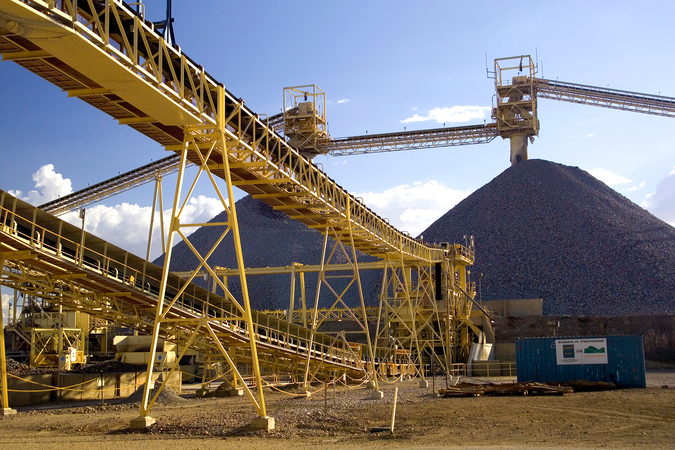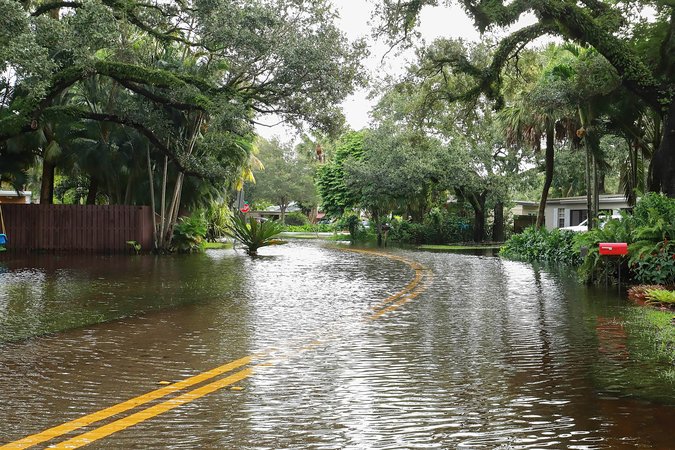Social Cost of Carbon Explorer
Explore how our open-source GIVE model produces updated estimates of the Social Cost of Carbon
Introduction
The Social Cost of Carbon Explorer is a data tool that allows users to generate updated estimates of the social cost of carbon (SCC), which is the dollar estimate of the economic damages from emitting one additional ton of carbon dioxide into the atmosphere. The SCC Explorer is powered by the open-source RFF-Berkeley Greenhouse Gas Impact Value Estimator (GIVE) model, and demonstrates how the parameters in each of the model's four sequential modules affect the final dollar estimate of the SCC.
How the Tool Works
GIVE Model
The SCC Explorer is a powerful tool for understanding the working mechanics of the RFF-Berkeley Greenhouse Gas Impact Value Estimator, or GIVE model. It shows how intermediate decisions about model assumptions ultimately affect the final SCC dollar value produced by the model.
The GIVE model consists of four sequential modules.
- A ‘Socioeconomic Module’, which contains projections of future ranges of population, GDP, and greenhouse gas emissions that drive climate change.
- A ‘Climate Module’ in which emissions projections from the first module are translated into four outputs, depicting different types of changes in the climate system, such as global temperature rise.
- A ‘Damages Module’, in which changes in the climate system are translated into economic damages due to impacts on things like agriculture and human health.
- A ‘Discounting Module’, in which future economic damages are added up over time and translated into present-day dollars, yielding estimates of the Social Cost of Carbon.
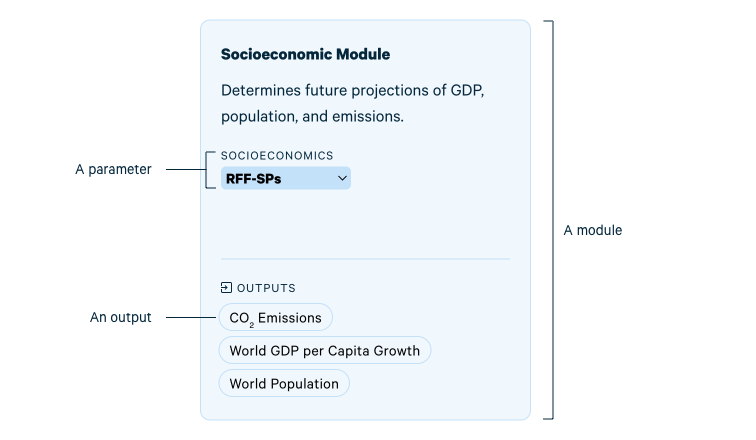
Parameters and Outputs
Within each module, one or multiple parameters can be specified using dropdown menus. You can select an output using buttons. The data outputs are depicted in two charts: a time-series chart on the left, and a histogram on the right.
Most time-series charts in the SCC Explorer depict median projections between 2020 and 2100, and are determined by the combination of modeling parameters specified in the dropdown menus. Clicking 'show all' in any parameter dropdown menu facilitates comparison across different parameters. Some data lines in the time series chart are surrounded by a shaded area, which depicts a 95% interval. This means that after running our model 10,000 times, the central 95% of pathways generated for this output fell into this range. The quantification of this uncertainty is a unique feature of the RFF-SPs. The SSP scenarios developed for the IPCC process only feature point estimates, so do not quantify uncertainty, and do not have a shaded area.
1. Socioeconomic Module
This module contains a single parameter:
- The socioeconomics parameter dropdown offers, by default, ‘RFF-SPs’. These are probabilistic projections of population, GDP, and greenhouse gas emissions developed by RFF’s Social Cost of Carbon Initiative and our collaborators. Also offered in the dropdown are various “Shared Socioeconomic Pathway” scenarios, or SSPs, which are used by the Intergovernmental Panel on Climate Change. Under the most optimistic of these pathways, SSP1, you can see a lower median emissions projection. SSP2 presents a more middle of the road future; SSP3 and 5 present more pessimistic projections.
The choice of socioeconomics parameter determines the values of three outputs from the first module:
- CO₂ Emissions—median projections of world carbon dioxide emissions each year between 2020 and 2100.
- World GDP per Capita Growth—annualized median economic growth rates from 2020. Because 2020 is our base year, the GDP per Capita Growth chart begins after that in 2030.
- World Population—world population, in billions.
2. Climate Module
This module translates emissions projections into changes in the climate system. It contains four parameters:
- The temperature dropdown offers the Finite Amplitude Impulse Response (FaIR) model.
- The sea level rise dropdown offers the BRICK model framework.
- The ocean pH dropdown offers Fung et al.'s empirical equation for estimating ocean acidification, detailed in Appendix F of Valuing Climate Damages (National Academies Press).
As indicated above, we only offer one modeling option in each of these dropdowns. These were selected based on our work to date. We plan to add more options here in future.
Four outputs can be selected in the climate module:
- CO₂ Concentrations—median projections of global CO2 concentrations.
- Temperature—median projections of world average temperature projections compared to pre-industrial levels between 1850 and 1900.
- Sea Level Rise—median projections of sea level rise relative to the year 1900.
- Ocean pH—median projections of ocean acidity (note that lower pH is more acidic, so a downward sloping curve indicates increasing ocean acidity).
3. Damages Module
This module translates changes measured in the Climate Module into economic damages, i.e. gives them a dollar value.
Two different approaches can be used to calculate undiscounted marginal damages: a sectoral approach, which is used by default, or an aggregate approach, which can be selected in the "method" dropdown menu.
The sectoral approach uses values specified in the following four parameter dropdowns to generate the projections seen in the charts:
- The health dropdown uses results from Cromar et al.
- The agriculture dropdown uses results from Moore et al.
- The energy dropdown uses results from Clarke et al.
- The coastal impacts dropdown uses the CIAM model from Diaz
As indicated above, our tool currently only allows one value to be selected for the health, agriculture, energy, and coastal impact damage sectors. We may offer more options here in future.
The alternative aggregate approach uses “top down” damage functions from the academic literature. They both use a single equation to estimate global climate-induced GDP losses as a function of temperature. The two included currently are:
- Nordhaus’s DICE damage function
- A damage function developed by Peter Howard and Thomas Sterner.
There is one output from the damages module:
- Undiscounted marginal damages—the damage, in dollars, in each future year caused by an additional ton of emissions in the year 2020.
4. Discounting Module
This module translates future economic damages into present-day dollars. One parameter is offered here:
- The discount rate represents how much weight is assigned today to impacts felt in the future. The higher the discount rate, the less weight is placed on future damages. The decision we make about the discount rate determines how the undiscounted marginal damages in the third module are added up and converted into a present value of damages, which is the social cost of carbon. Our model is saying that, “given the decisions we made through the four modeling steps, emitting one additional ton of CO2 in the year 2020 will create a stream of economic damages valued at $185 on average.”
A Note on Discounting Methods
Note that for projections that use the RFF-SPs socioeconomic parameter, we use "Ramsey discounting," meaning that the discount rate is linked to the rate of economic growth while also matching the chosen discount rate value (such as 2%) in the short-run. In the case of the Shared Socioeconomic Pathways, or SSPs, we use constant discounting, meaning the discount rate is not linked to economic growth but is instead simply a fixed value equal to the chosen discount rate value. We discuss the reason for this approach in our “Advances in Long-Term Probabilistic Projections” paper. The Ramsey approach using the RFF-SPs is preferable, but nonetheless we show the SSPs with constant discounting for comparison purposes.
There is a single output from the final model:
- The social cost of carbon is the value, in present-day dollars, of the economic damages that result from emitting one additional ton of carbon dioxide into the atmosphere. Note that unlike previous outputs, we are looking at a projection of the mean rather than median value for this output. We do this because the mean, or average, SCC is typically the primary estimate used in benefit-cost analysis.
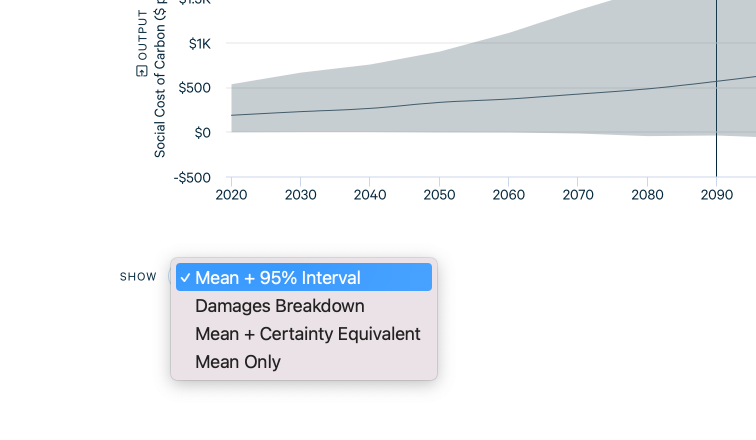
Show Menu
The “Show” menu at the bottom left of the screen changes what is displayed in the time series chart. By default, the median value (or, in the case of the SCC, mean value) of the output plus the shaded 95% interval is displayed. Another option here is to remove the 95% interval by looking at the mean only. When viewing the social cost of carbon output, and when no parameter is set to 'show all', two additional menu options are available: first, users can also view the mean with the certainty equivalent (see accompanying note below). Second, a “Damages Breakdown” option shows how the mean value is made up of damages from each of the sectors listed in the damages module. Note that this option is only available when the method parameter is set to "sectoral."
A Word on the Certainty Equivalent
The certainty equivalent differs from the mean, or average, value in future years in that it incorporates the value of uncertainty about the future. The certainty equivalent value is typically lower, reflecting the fact that future climate impacts as measured in dollars tend to be larger when society is wealthier—since there are more assets to be damaged by changes in the climate—and those wealthier societies tend to place less value on each additional dollar of damages. While the mean and the certainty equivalent values are similar over the next few decades, the differences are larger in the further future. Looking at 2100, we see that the certainty equivalent value is as much as 40% smaller than the mean value.
When an SSP scenario is selected, the certainty equivalent is the same as the mean value. This is because the SSP scenarios use point estimates, and do not individually quantify uncertainty about future socioeconomic or emissions outcomes.
Histogram
The histogram chart on the right side of the tool displays the distribution of values generated by model runs in groups, or “bins”. A user can click anywhere on the time series chart to select a year to use in the histogram chart. For instance, if the year 2020 is selected, the time series chart shows a mean value for the Social Cost of Carbon in 2020 of $185, which corresponds with the mean value depicted by the dotted line in the histogram. But the histogram also groups the distribution of values generated by our 10,000 model runs. Hovering over these values shows, for instance, that about 2,000 of the 10,000 model runs generated a social cost of carbon, in 2020, of less than $100 per ton, and about 4,000 fall between $100 and $200 per ton. Switching to the year 2100 reveals that, in some instances, the final value in the histogram is larger than those around it, since it incorporates values that fall outside the axis range depicted in the chart.

Greenhouse Gas Selection
The data tool covers greenhouse gases beyond carbon dioxide. Users can change the greenhouse gas being viewed to methane or nitrous oxide using the dropdown menu in the top right corner of the tool.
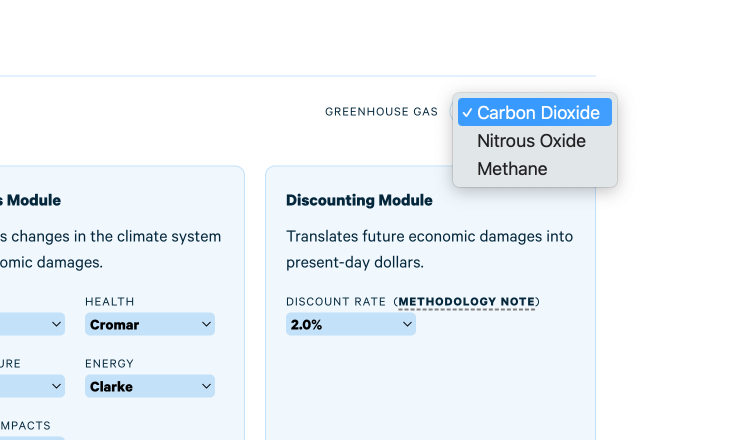
Video Tutorial
Feedback
If you have any questions about the SCC Explorer, the GIVE model, or wish to report a bug or error, we always welcome your feedback. Please email [email protected].




